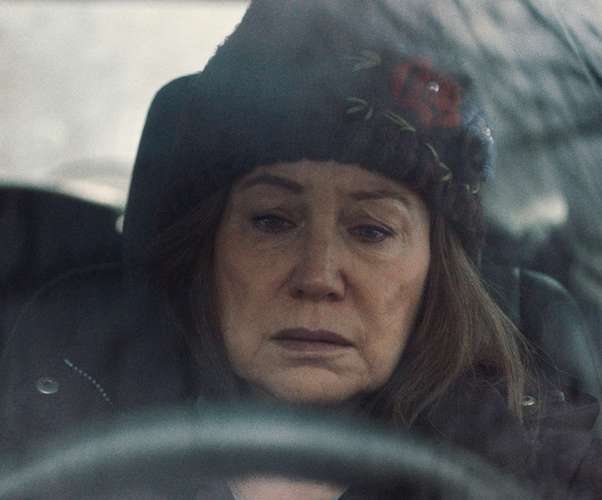Film Review: “Diane” — Heroine of a Different Stripe
By Erica Abeel
What elevates these ordinary lives is director Kent Jones’s elegiac distance; the narrative has the feel of a memory piece.
Diane, directed by Kent Jones. Screening at the Kendall Square Cinema starting on April 5.

Mary Kay Place in “Diane.”
I’m not sure when the trend began — and whether it will continue — but middle-aged women have begun moving from the periphery in films to the center. No longer minor characters, they have become the heroines of their own lives. This vogue could be a reflection of the second coming of Second Wave feminism — at one time a topic as welcome as a Norovirus — and its current prominence in public discourse. We recently had the Chilean-Spanish Gloria from Sebastian Lelio, followed by Gloria Belle, his English-language iteration with Julianne Moore. Let the Sunshine In from the reliably quirky Claire Denis foregrounds Juliette Binoche as a middle-aged woman navigating a cast of lovers ranging from meh to toxic.
But Diane, the debut narrative feature by Kent Jones, marks off a new subset of films about older women. Juliette Binoche (55) with her lush autumnal beauty, appears movie-star middle aged, and the same goes for Julianne Moore (58). (I include their age, an irritating media tic, because here it’s relevant.) Rather than reflect their age, their looks defy and glamorize it.
In Diane, the eponymous heroine played by Mary Kay Place feels far closer to nitty-gritty reality, thanks to Jones’s refusal to depict her through a sexualized male gaze. Though by any standard an attractive woman, the challenges life hurls Diane’s way, as well as the resources she must marshal to weather them, are mirrored in a permanent anxious frown. Hers is not the face of a woman seeking the affirming gaze of men — it’s the face of a woman in a day-to-day battle to survive. And you never want to look away.
Inspired by members of Jones’s own family, the hard-scrabble characters are boomers clustered in a rural blue collar area (upstate New York standing in for what looks like Pittsfield, Massachusetts). At moments, the widowed Diane, besieged by yet another fresh tribulation, feels like some latter-day female Job. Top of the list, her son Brian (Jake Lacy, excellent), is a heroin addict fast-tracked for destruction. When she brings him clean laundry and care packages, and begs him to return to rehab, he shockingly calls her a cunt — yet she can’t stop trying to rescue him. She lives in terror of a phone call announcing he’s OD’ed. “Only he can do it for himself,” Diane’s friends recite like a mantra. Try telling that to a mother.
In between frantic visits to Brian’s squalid rooms, Diane hits the bleak New England roads to visit a cousin hospitalized with terminal cancer. While the two play gin rummy, the cousin alludes to a past betrayal by Diane that she has forgiven, “but not forgotten” — a remark that will resonate in the third act reveal. Diane, whose existence is a round of service to others — possibly to atone for that betrayal — also works in a soup kitchen and brings casseroles to an ailing friend. Her single respite is the community she finds with friends and family, gathered round a dining room table, the women in tatty housecoats, themselves worn down by infirmity and age, yet buoyed by humor and camaraderie. Jones’s camera sometimes holds on their faces — including that of marvelous Estelle Parsons — the way cinematographers of Hollywood’s Golden Age shot movie queens.
On first hearing a thumbnail description of Jones’s film, I thought, uh-oh, another exercise in miserabilism (a cinematic trend our current world justifiably inspires). But no: the film depicts woeful lives, but through artistry and craft Jones goes beyond an easy recording of misery. Mary Kay Place (who the director always intended for the role) gives us an astonishing heroine of a different stripe. Her demeanor makes the will to endure visible, palpable; her clashes with Brian are feral and raw. The scenes shot from Diane’s car as she drives through the countryside inject a chilly melancholy, mitigated by flickers of twilight gold You may never look at wintry woods and modest frame houses in the same way. Jones positions the driving interludes almost musically, as a refrain; cutaways from the mess of human lives. He ironically gestures at Wong kar-wai’s exquisite interiors by transforming shabby local diners strung with Christmas lights into bejeweled wonderlands.
For conventional plot the narrative substitutes something more sinuous and wayward — like the hairpin curves in the road? — a sense of time unspooling. People in the film visibly grow older (Diane is white-haired by the end). Dear friends die. Diane’s son Brian replaces addiction to heroin with religious fanaticism; in a darkly funny reversal, Brian tries to “convert” and rescue his mother. What elevates these ordinary lives is the director’s elegiac distance; the narrative has the feel of a memory piece (Jones has said he’s been mulling over his family’s stories some forty years). One of the film’s most beautiful lines is spoken by a black man who’s become a source of comfort to Diane at the soup kitchen where she works. “When you serve me Diane,” he says, “I feel sanctified.” Through this powerful look back, Jones ennobles these embattled folks.
Erica Abeel is a novelist, film and cultural critic, and former professor at CUNY. Her recent novel Wild Girls, about three women rebels of the 50s, was an Oprah Magazine pick. Her journalism has appeared in the New York Times, Indiewire, and other major sites and national publications. A former dancer, when not writing, she’s in a Pilates class or at the barre.
